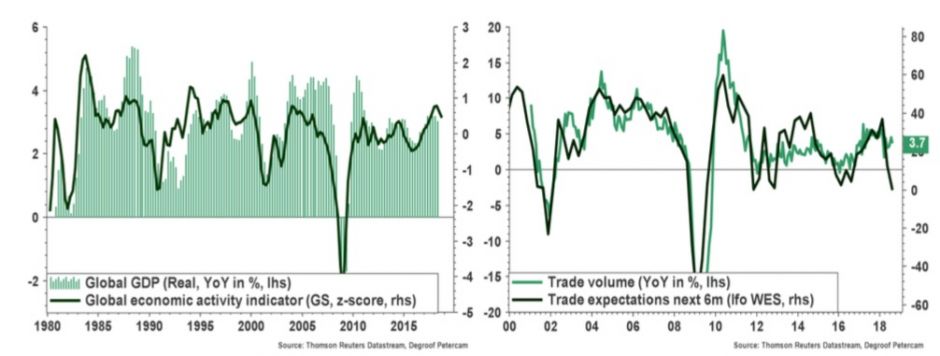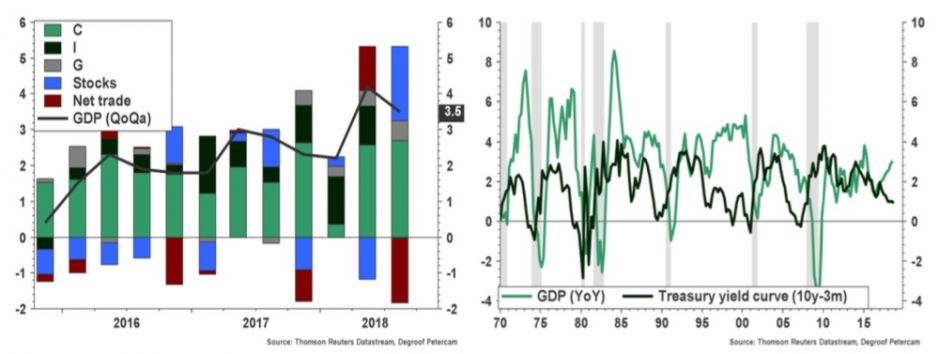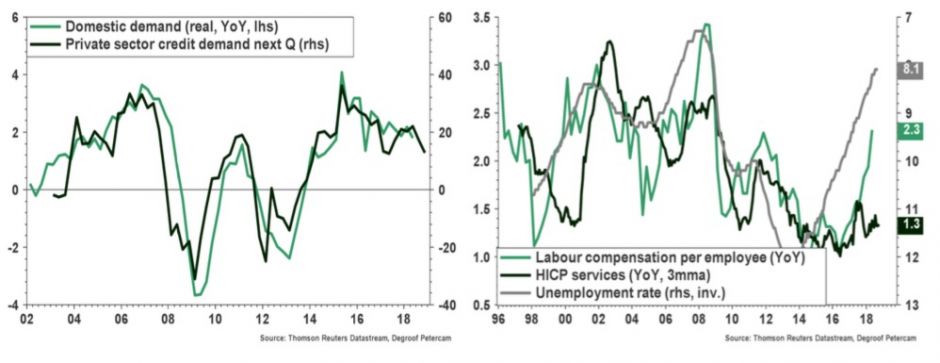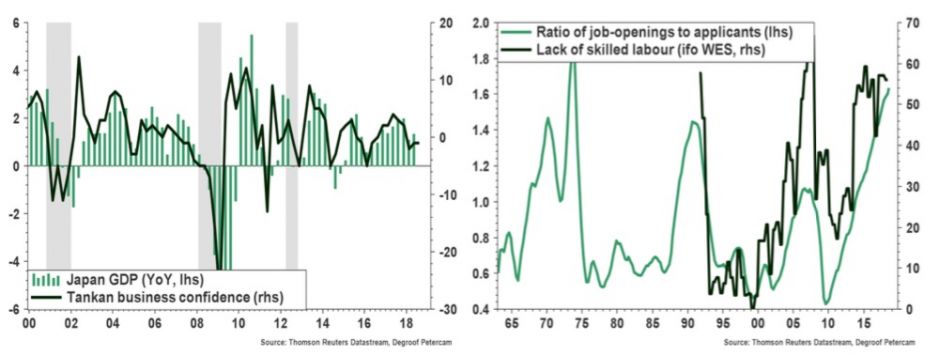
Degroof Petercam: Global economy is cooling
The sharp equity sell-off in October suggests investors are coming to terms with the rise of downside risks. Chief among these risks is global protectionism.
14.11.2018 | 15:19 Uhr
While current tariffs are still modest and the tone of debate between the US and China seems to soften a touch, the risk of escalation remains high. Moreover, expectations for global trade already point to further deceleration in the months to come. The expected slowdown in trade is consistent with reduced prospects for global growth. So far this is unlikely to deter the Fed from raising interest rates in December, especially now that the US economy is still growing strongly and inflation pressures are building. But the strong dollar, global trade tensions, rising interest rates and fading effects of US stimulus look set to translate into slower US growth in 2019. Meanwhile, China is facing the combined impact of trade measures and the slowdown in the domestic economy, on top of its long-term challenges. On the inflation front, despite the strong cyclical global recovery over the last two years, wages and prices have reacted only modestly. There has been a lot of talk about the death of the Phillips curve but it might be premature to confirm that message. All in all, inflationary pressures are slowly but gradually building. At the same time, other factors including globalization, technological change and digitization, the ageing of the population, insufficient labour union power, lower anchored inflation expectations and sluggish productivity growth suggest that inflation is unlikely to break out any time soon. Indeed, in recent years wage growth has become less sensitive to changes in labour market conditions.

US growth still unsustainably strong
The US economy has fired on all cylinders over the past two years. Nevertheless, and fully in line with expectations, Democrats are now taking back the majority of seats in the House of Representatives, suggesting the Trump administration will face more constraints until the next Presidential elections in 2020. In any case, big changes to economic policy after the midterms are unlikely. In theory, Democrats and Republicans could strike a deal over both lower taxes for the middleclass and more investment spending. However, in the current highly polarized political climate chances of that happening are relatively low. Political tensions may well increase further as Democrats now hold the power to set the agenda in the House, possibly translating into a fiscal gridlock (government shutdown and/or debt ceiling conflict). Surveys are sending mixed signals on the direction of the US business cycle. Third quarter GDP growth (3.5% QoQa) was boosted by inventories while investment stalled and net trade contributed negatively. All in all, however, the overall picture remains one of a robust expansion supported by fiscal tailwinds. The United States are currently seeing the second-longest economic expansion in history. That said, it is difficult to see how this pace of expansion can be sustained for much longer. President Trump’s tax reforms have been boosting economic growth in the short term but will primarily result in deteriorating public finances (towards a deficit of around 4 to 5% of GDP) and growing inequality over time. Moreover, further monetary tightening in the US will eventually bite into economic activity. Interest rate sensitive areas of the economy such as housing are already showing signs of weakness. Meanwhile, the yield curve remains relatively flat from a historical perspective. This is something to monitor closely as it tends to go hand in hand with slower economic growth further down the road. Another important risk is the uncertainty on trade. The conflict between the US and China remains unresolved even though we are seeing some softer talk on trade more recently. But remember, tensions go beyond the US trade deficit. Indeed, China’s economic, cultural and technological rise over the last three decades have also undermined the US superpower status. The economic impact from tariffs on Chinese imports remains small so far but a global trade war and equity slump would be costly. That said, recession odds are still low for now. While housing data such as weaker building permits are raising concerns, the gap between fundamentals and home prices is nowhere near the gap at the onset of the Great Financial Crisis. What’s more, both consumer and business confidence look strong. Inflation is rearing its head again, albeit still modestly, as the labour market is nearing full employment. The strength of the economy should convince the Fed to hike rates again in December. Of course, in case significant volatility in financial markets resurfaces, it may convince the Fed to be more cautious. Further significant flattening of the yield curve over the coming months could well prompt the Fed to pause its monetary tightening efforts at some point in 2019 when the pace of economic growth is likely to slow down.

Eurozone economic activity falling back towards potential
Weakness in industrial activity, partially reflecting temporary factors such as the implementation of new emission testing procedures in the car industry, and lacklustre confidence indicators suggest that the pace of economic activity is softening. The latest eurozone PMI data are back at levels last seen in 2016. The European economic cycle has seen solid improvement since the second half of 2016 on the back of ample spare capacity and economic activity is now falling back to growth rates more in line with potential. The eurozone unemployment rate has dropped back to just over 8% and wage growth is finally picking up, implying that underlying price pressures should move somewhat higher from here. That said, headline inflation (now at 2.2%) will be negatively impacted by base effects related to the evolution of energy prices. All in all, the ECB is still on course to end its asset purchases by the end of this year. But it is too soon for an actual rate hike. As things stand, the first rate hike will probably not come before the summer of 2019. Italy’s new populist Eurosceptic coalition government will remain a source of uncertainty for both Italy and the Eurozone. Confidence in Italy has dropped significantly following the elections earlier this year and the budget dispute with the European Commission. More confrontations between the Italian government and the EU in the months ahead are likely and will go hand-in-hand with bouts of volatility. Meanwhile, Brexit-negotiations are still proceeding slowly. The UK and EU are hoping to finalise the so-called divorce agreement and agree a statement on their future economic co-operation in time. But it remains to be seen whether this is feasible considering the opposing views coming from within the Conservative party. More broadly, Macron’s rapidly declining popularity and Chancellor Merkel’s uncertain position following recent regional elections raises even more questions about much needed institutional reforms in the eurozone.

Boj remains put and looks at financial vulnerabilities
Economic activity in Japan has clearly softened since the start of the year. Meanwhile, incoming inflation prints remain modest. Underlying price pressures may strengthen a bit further on the back labour market tightening and accelerating wage growth. An increase in the regular earnings number encouraging in this regard. Survey evidence still points to a lack of skilled labour and a high ratio of job-openings to applicants. But so far core inflation has increased only a bit. The BoJ remains firmly in easing mode, allowing only technical adjustments to its policy of yield curve control for now until more evidence of price pressures appear. In addition, the Boj issued a stronger warning for side-effects of its policies on financial intermediaries over the long run.

Chinese credit slowdown takes its toll on growth
Budgetary and monetary policymakers in China are stepping up efforts to arrest the ongoing slowdown spurred by a decline in credit growth and international trade tensions. Renminbi depreciation, lower interbank interest rates, tax cuts and extra investment spending should at some point produce stabilizing results. But for now at least the risks are still tilted to the downside. More broadly, the situation in the emerging world is very different from region to region and from country to country. Recent upheaval in EM financial markets has sparked comparisons to the debt crises of the 1980s and 1990s. True, tightening financial conditions usually herald a more difficult environment for emerging markets. That said, the analogy looks of the mark. Apart from Turkey and Argentina the risks facing most EMs today are significantly smaller. Indeed, the vulnerability of EM in general is lower compared to past decades. Many EM have improved their macroeconomic frameworks, including the use of flexible exchange rates, ample reserve buffers and multiple financial safety nets. Still, pre-emptive tightening efforts of EM central banks may hurt economic activity in the months ahead. For more info, please see this blogpost. In Brazil, the extreme-right Jair Bolsonaro emerged as the winner from the elections. He will be confronted with a challenge. The sustainability of Brazil’s public finances will depend on the continuation of the ongoing public spending reforms. In India, the spat between the Modi government and the central bank has raised questions on the independence of the central bank in the wake of a default of a major infrastructure funding company (~shadow bank).





Diesen Beitrag teilen: